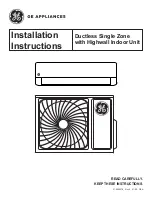
5 Installation
Installation and operation manual
10
5TMV1B
VRV IV-S system air conditioner
4P399985-1B – 2015.06
To handle the service port
▪ Always use a charge hose equipped with a valve depressor pin,
since the service port is a Schrader type valve.
▪ After handling the service port, make sure to tighten the service
port cover securely. For the tightening torque, refer to the table
below.
▪ Check for refrigerant leaks after tightening the service port cover.
Tightening torques
Stop valve
size (mm)
Tightening torque N•m (turn clockwise to close)
Shaft
Valve body Hexagonal
wrench
Cap (valve
lid)
Service
port
Ø9.5
5.4~6.6
4 mm
13.5~16.5
11.5~13.9
Ø15.9
13.5~16.5
6 mm
22.5~27.5
5.3.2
To connect the refrigerant piping to the
outdoor unit
NOTICE
Be sure that the field installed piping does not touch other
pipes, the bottom panel or side panel. Especially for the
bottom and side connection, be sure to protect the piping
with suitable insulation, to prevent it from coming into
contact with the casing.
1
Do the following:
▪ Remove the service cover. See
"5.1.1 To open the outdoor
unit" on page 8
.
▪ Remove the piping intake plate (a) with screw (b).
a
b
2
Choose a piping route (a, b or c).
a
b
c
3
If you have chosen the downwards piping route:
▪ Drill (a, 4×) and remove the knockout hole (b).
▪ Cut out the slits (c) with a metal saw.
c
c
b
a
4× Ø6 mm
4
Do the following:
▪ Connect the liquid pipe (a) to the liquid stop valve.
▪ Connect the gas pipe (b) to the gas stop valve.
a
b
5
Reattach the service cover and the piping intake plate.
6
Seal all gaps (example: a) to prevent snow and small animals
from entering the system.
a
WARNING
Provide adequate measures to prevent that the unit can be
used as a shelter by small animals. Small animals that
make contact with electrical parts can cause malfunctions,
smoke or fire.
NOTICE
Make sure to open the stop valves after installing the
refrigerant piping and performing vacuum drying. Running
the system with the stop valves closed may break the
compressor.
5.4
Checking the refrigerant piping
5.4.1
About checking the refrigerant piping
Refrigerant piping works are
finished?
The indoor units and/or
outdoor unit were already
powered ON?
Use procedure:
"Method 2: After power ON".
Finish piping work.
Use procedure:
"Method 1: Before power ON
(regular method)".
Yes
No
No
Yes
It is very important that all refrigerant piping work is done before the
units (outdoor or indoor) are powered on.
When the units are powered on, the expansion valves will initialise.
This means that they will close. Leak test and vacuum drying of field
piping and indoor units is impossible when this happens.
Therefore, there will be explained 2 methods for initial installation,
leak test and vacuum drying.
Method 1: Before power ON
If the system has not yet been powered on, no special action is
required to perform the leak test and the vacuum drying.
Method 2: After power ON
If the system has already been powered on, activate setting [2‑21]
(refer to
"6.1.4 To access mode 1 or 2" on page 16
). This setting
will open field expansion valves to guarantee a R410A piping
pathway and make it possible to perform the leak test and the
vacuum drying.











































